
33 minute read
Museums & Monuments
from The Berlin Bunch
WHAT TO DO IN BERLIN TODAY?
PHOTO: POTSDAMER PLATZ, page 32
Advertisement
Sankt-Hedwigs-Kathedrale

St. Hedwig Cathedrale
St Hedwig’s Kathedral is located on Bebelplatz, fve minutes walk from Alexanderplatz by the Bibliothek Memorial and Humboldt-University. It’s the frst Roman Catholic cathedral built in Berlin after the Reformation, originally constructed between 1747 and 1773 and was repaired and reconstructed after the Second World War. The main church feels very grand with its high domed ceiling and large contemporary artwork behind the altar, while the small chapels on the lower level provide more intimate spaces for prayer and contemplation. It has a very quiet atmosphere, broken only by free daily short organ concerts and masses. Although very large physically, there are other sights nearby that overshadow the cathedral in terms of fame and as “must-see” attractions. However, the cathedral’s exterior architecture is defnitely Instagram-worthy, and the interior is also worth a look if you have ten to ffteen minutes to spare. If churches and church music are more your thing then it is possible to look at their website for times for free organ concerts or arranging tours. Information within the cathedral on its history is all in German, so you would have to either brush up on your language skills or visit their website for English versions.
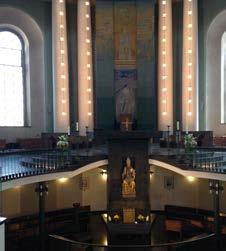
Niederwallstraße 8–9, 10117, Mitte | Varies | Hausvogteiplatz hedwigs-kathedrale.de
Words: Kait Macdonald
Denkmal für die im Nationalsozialismus verfolgten HomosexuellenMemorial to Homesexuals persuted under Nazism

Finished in 2008, the Denkmal für die im Nationalsozialismus verfolgten Homosexuellen was built in memory of homosexuals who were killed during the Second World War. Under the Nazi regime, homosexuals were forced into labor camps. They were slowly worked and starved to death for no other reason other than that they were gay. This memorial was built to commemorate them. Located in Tiergarten Park near the Goethe Monument and across the street from the Memorial to the Murdered Jews of Europe, its shape is a large stone block. Its similarity in structure to the dozens of stones that make up the Holocaust Memorial brings a sense of unity between them. They are also right across the street from each other. Someone interested in history could easily walk from one to the other. What makes this memorial unique is that there’s a window to look into. Inside is a looping video of two young men kissing. The size of this smooth stone is impressive and yet there aren’t any carvings or other artwork to admire. Although it was made for a good reason, it’s a let-down to see that it’s just a large stone. It’s not worth seeing unless one happens to be nearby or is interested in history.
Topographie des Terrors Topography of Terror

The headquarters of the Gestapo and the SS, the main institutions of Nazi persecution and terror, used to be based here. Most of the original buildings were destroyed during the Second World War and the rest were demolished afterwards. This place has a vast indoor and outdoor exhibit so plan on spending at least three hours here. The exhibition mainly covers Hitler’s ascent to power and narrates the actions of his regime towards the Jews, homosexuals, disabled people as well as the Aryan race. After visiting you will have a better understanding of the Nazi regime, as there is a lot of detailed information and pictures. Even though this is often referred to as “a must do” while in Berlin, people visiting should be keen on history as the amount of information may be too much for casual visitors. Wearing sunscreen is recommended, as visitors will be out in the sunshine for about an hour while seeing the outside exhibition
Located opposite the Berlin Dom, this museum focuses on the daily life of East Germany rather than the more common topics like the governmental oppression, the Berlin Wall and the Stasi. The way the museum shares the information is unique as they combine all the concepts with interactive activities. The exhibition will take you back in time as you see the products the East Germans had access to, their clothes and games. The museum recreates the living room of a typical East German apartment and also lets you drive a Trabi (the most common East German car). You will spend your time in the museum opening cabinets, trying on military clothes, writing your name in Russian or creating the perfect new socialist human. Overall this museum is fantastic and achieves its main aim, which is to show you the daily life in the DDR with its problems, government and joys. As it is a very popular museum expect it to be crowded. It’s recommended to buy tickets online, as it’s cheaper.
Niederkirchnerstraße 8, 10963, Kreuzberg | 10.00-20.00 | topographie.de Mohrenstraße| €€€€€ |
Words: Erica Reyes
DDR Museum

Words: Erica Reyes
Neue Wache New Guardhouse

Originally built as a guardhouse for a Prussian palace, the Neue Wache has been Germany’s central memorial to victims of war and tyranny since 1993. The building has housed several different memorials since 1931, when it was frst used to commemorate victims of the First World War. It is an austere building with a row of Greek columns along the front. Inside is one large room with a sculpture in the centre, Mother with her Dead Son by Käthe Kollwitz, one of Germany’s most famous artists. A circular hole in the ceiling leaves it exposed to the elements. The memorial received a fair amount of criticism, not least because its rather unspecifc aim of trying to include all of Germany’s war dead, the victims of the Holocaust and the victims of the GDR dictatorship means it doesn’t end up feeling like it adequately serves any of them. It’s worth a look if you’re in the area and want to make up your own mind but otherwise there are plenty of other more interesting sights nearby, such as the Berliner Dom and Museum Island.
Unten den Linden 4, 10117, Mitte | 10.00-18.00 | Bus 200 Staatsoper | | €€€€€ |
Words: Zoë Charlesworth
Kaiser Wilhelm Gedächtniskirche

Kaiser Wilhelm Memorial Church
Situated on Lietzenburger Straße, just at the intersection of Kurfürstendamm, the Kaiser Wilhelm Memorial Church is hard to miss. The ruined church is a stark contrast to its surroundings and it immediately draws your attention. It is named after the frst Kaiser Wilhelm who was in power in Germany in the late 1800s. First built in 1865, this church, like the city of Berlin, has been through a lot. During a bomb raid in the Second World War the church was decimated and left in ruin.
What is left is the 68m tall ruin of the tower called “hollow tooth” by Berliners.
The restoration process was completed in 1963 and it included a sanctuary next to the tower to hold services which are regularly held on Sundays and holidays. The tower is now regarded as a memorial against war and violence. The inside of the tower itself is quite underwhelming; it’s not as big as you think it is when you look at it from the outside. The ceilings are adorned with beautiful artwork and there are various chalices and artifacts from the rubble of the church. There are free guided tours in English three times a day and it is also wheelchair accessible via an alternate entrance.
Breitscheidplatz, 10789, Charlottenburg | | €€€€€ | gedaechtniskirche-berlin.de Varies | Kurfüstendamm

OlympiastadionOlympic Stadium
Built for the 1936 Olympic Summer Games in Berlin, the Olympiastadion is an epic combination of visual history and beautiful architecture. Clearly reminiscent of ancient sport facilities, the stadium is very well preserved and even fairly modernised inside with a cheaply priced restaurant to enjoy. With strong intentions from the Nazi party to use the building for their National Socialism propaganda of building a new and better Germany, the place famously played host to American athlete Jesse Owens. As the most successful Olympian that year, Jesse Owens is known to have disproved Hitler’s theory of Aryan race supremacy. Also host to the 2006 Football World Cup and continuously used for the German Cup fnal since 1985, the stadium feels very patriotic and proud, and no doubt the atmosphere during a match would be something worth experiencing! Tour guides are available to give in-depth information on the venue; however, for those who opt out of a tour guide, it is fairly lacking in further information or much sense of direction in the open space. Olympiastadion is reasonably apt for all weather conditions and possibly of interest to the majority, though this comes highly recommended for those with a passion for history. Notably, several school trips seem to pay a visit here. Made for a capacity of 100,000 spectators, the magnifcent space is a slightly lengthy ride to the end of the U2 U-Bahn line. Olympiastadion is certainly worth a visit, but perhaps not to be made a top priority. However, combined with a trip down to the stunning views of Grosser Wannsee Lake and to some decent ice-cream shops, it can’t be all bad.
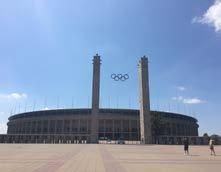

Olympischerplatz 3, 14053, Westend | Varies | Olympiastadion |7€/5.50€ | olympiastadion-berlin.de
Stasi Museum
Stasi Museum

The shady headquarters of the former Stasi, the infamous GDR Ministry for State Security, were located in this very building which today houses Berlin’s Stasi Museum. At one point in time, the Stasi had 180,000 civilian informants spying on their neighbours. Tucked away on Ruschstraße, this impressive museum can be a little tough to find. It is quite far from a lot of the popular tourist destinations in Berlin and a decent walk from the closest U-Bahn station. Inside the museum there are exhibits and artefacts from the former Stasi headquarters, and lots of documents and old photographs from the height of the Cold War. Including diaries of people reporting on what their neighbours are doing. On the second floor, a blast from the past occurs where the old offices and meeting rooms of the Stasi higher ups have been kept. The third floor contains artefacts from the end of the GDR and the Stasi. This museum is worth a visit as it explains a large part of Berlin’s history; the fact that it is fairly cheap for students to visit is a bonus as well.
Rusch Straße 103,10365, Lichtenberg| 10.00-18.00| stasimuseum.de Magdalenstraße|6€/4.5€|
Words: Ryan Stelter
Die Mauer Asisi Panorama
The Wall Panorama

To escape the hoards of tourists at Checkpoint Charlie, take a short walk across the street to “Die Mauer” where there is truly a magnificent 18-metre-high panorama to be seen. On Mondays you can pay to see whatever you think it is worth. It is certainly worth the price of admission no matter what day it is. Walking into the 900 square foot panorama is breathtaking. The artist, Yadegar Asisi, does a wonderful job of capturing what it would have looked like to have lived by the wall. You are meant to be standing on a terrace in West Berlin looking over the death strip into the desolate East. In the background you hear the sounds of cars and people talking to help make the experience real. There are also clips of John F. Kennedy as well as other German politicians making quips about the wall. It is a moving experience. One of the best ways to experience what life was like during the time of the Berlin Wall in the 1980s. The panorama is complemented by a photo exhibition with over 100 photos from contemporary witnesses who give their own personal stories with each photo.
Friedrich Straße 205,10117 Kreuzberg| 10.00-18.00| 10€/8€ | asisi.de Kochstraße |
Brandenburger Tor Brandenburg Gate

This was once a gateway into Berlin. During the Cold War, the Brandenburg Gate was a symbol of the stark contrast between the divided East and West. Since the fall of the Berlin Wall, however, the Brandenburg Gate has been a symbol of unity. The sculpture on top is of the Goddess of Victory, which was added to the design in 1793. It’s very busy and crowded. Tourists surround the area, but there are also locals who pedal bicycles through the crowds. Add the traffc on the nearby road to the general chaos and you get a cacophony of people speaking, cars honking, and bodies rushing. Although impressive, there isn’t anything to do there except take a few selfes. There are some places nearby to check out, though. There is a Starbucks in the square that’s good for a quick drink with tables to sit down and rest. The Tiergarten is across the street, which has historical monuments throughout it. Also, within walking distance, is the Holocaust Memorial.
Pariser Platz 1, 10117, Mitte | Bus 1 Reichstag/Bundestag | €€€€€ |
Words: Gabrielle Archibald
Siegessäule

Victory Column
Berlin’s Victory Column undoubtedly gives the best panoramic view of the city’s skyline. The gold, winged goddess Victoria stands tall on top of the tower and makes for a dazzling contrast against a blue sky. The column is situated on an intersection of fve avenues in the heart of Tiergarten and can be seen from the Brandenburg Gate. Once inside, there are a series of miniature sculptures to look at and read about, such as London’s Big Ben and the Empire State Building. Though the tower demands an exhausting 285 steps to get to the top, it’s most certainly worth the effort for the rewarding view. However, those with a fear of heights might want to take a few deep breaths before making their way up. The staircase is narrow and can become cramped on busy days, so hold on tightly to that bannister! If you are in Tiergarten and like the idea of taking some nice photos, then it’s worth heading over to the Victory Column.
Großer Stern 1, 10557, Mitte | Varies| Bus 100 Großer Stern | 3€/2.50€
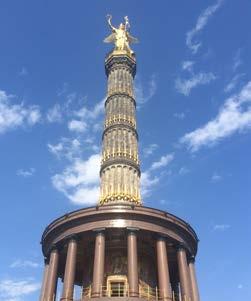
Reichstag

Government Building
Located just a short walk away from the Brandenburg Gate, the Reichstag is the home of the German government. The Bundestag is one of the most visited parliaments in the world, with three million people coming to visit every year. The Reichstag has been the home of German democracy since 1999 and visually it is a stunning building. Originally constructed in 1894, the Reichstag has undergone a lot of change. The old exterior has an imposing look, but upon walking inside it is very modern with high ceilings. The tour of the dome on the rooftop terrace is the frst thing that should be done when arriving in Berlin, as it gives you a magnifcent panorama view of Berlin.
The views from the top are absolutely spectacular, and if possible book a tour in the evening as the setting sun provides opportunities for some beautiful pictures of the Berlin skyline. Yes, you do have to book a tour, but it’s free of charge and so worth it. If you know you’ll be coming to Berlin, it is recommended to book this tour on their website in advance. The audio guide (which is the best audio guide ever by the way) starts as you walk up the ramp and tells you to stop and explains what you are looking at. The audio guide takes you through an aerial view of the city and all its biggest tourist attractions. The construction of the dome stresses openness as you look down you can see the Planery chamber where the members of parliament sit. The idea is to have the elected members of government look up and see those they are working for: the people. This is one of the coolest tours that can be done in Berlin and the fact it’s free is a big bonus.
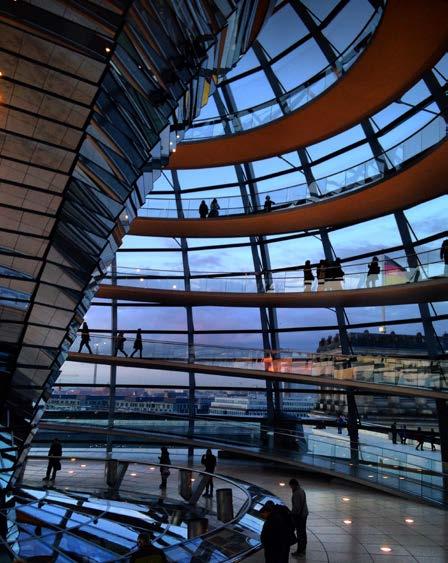
Platz Der Republik 1, 11011, Mitte | 8.00-00.00 | Brandenburger Tor| €€€€€ | bundestag.de
Words: Ryan Stelter
Gedenkstätte Berliner Mauer Berlin Wall Memorial

The Berlin Wall Memorial extends 1.4 km along Bernauer Straße on the former border strip between East and West Berlin. The effect of the Wall was especially dramatic here because the front of the buildings on the East side of the street formed part of the border. The principal part of the memorial is an open air exhibition, incorporating historical remnants of the border, which makes the former division of the city feel tangible. Hundreds of tall metal rods run along where the Wall once stood and markers on the ground show other border features and locations of escape tunnels. It is the main site of commemoration for the victims of the Berlin Wall and the offcial dedicated monument is a reconstructed section of border fortifcations with a guard tower. There are also two indoor exhibitions which give more information about the political and historical context. Whether you want to spend a few hours reading all the information or spend 15 minutes walking along the length of the memorial, it’s the best place to get an impression of the size of the Wall and the devastating impact on the city and its people.
Bernauer Straße 111, 13355, Mitte | Nordbahnhof | €€€€€ |
berliner-mauer-gedenkstaette.de
Open air: 24 hours; Indoor exhibitions: vary|
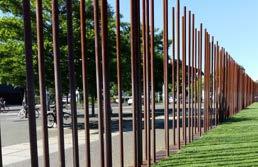
Words: Zoë Charlesworth
Das Denkmal zur Erinnerung an die
Bücherverbrennung Book Burning Memorial

Situated just across from Humboldt University lies the Bibliothek Memorial. Although seemingly insignifcant due to the massive construction site just beside it, the memorial is a representation of a deep past. The site at Bebelplatz is the location of the Nazi book burning that occurred in 1933 by the nationalist German Students’ Association. Over 20,000 books were burned at this ceremony. Put in place by Micha Ullman, this memorial of a glass window overlooking empty bookshelves now sits in the middle of the square. Next to the memorial is a plaque, which translates to, “That was only a prelude; where they burn books, they will in the end also burn people.” The fact that this memorial is just one small window in the middle of the square is a profound reminder of how horrifc a time this period was. Aside from being located just across from Humboldt University, Bebelplatz square is near the State Opera building, St. Hedwig’s Cathedral and the German History Museum.
Sowjetisches Ehrenmal

Treptow Soviet War Memorial
Located within the borders of the vast Treptower Park is the Soviet Memorial. The frst thing one sees is a large statue of a soviet soldier holding a German child and a sword while standing on a broken swastika. This statue, designed by Mikhail Gorvits, is there to commemorate Nikolai Masalov, the Sergeant of Guards, who risked his life in the midst of battle fre to save a German child whose mother had disappeared. Lining the courtyard are 16 stone walls to represent the 16 Soviet Republics. One side of the strip is in Russian and the other is in German. The memorial is a cemetery for about 5,000 Red Army soldiers. While walking through it, the feeling is quiet and rather eerie, but it is unmistakably beautiful. At the platform of the statue is a dark room. To this day, individuals can be seen placing their fowers inside of it in remembrance of the fallen.
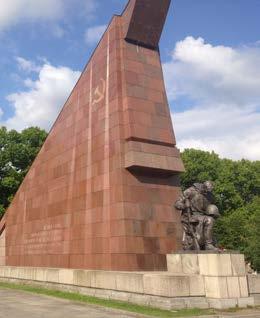
Puschkinallee, 12435, Alt-Treptow | Treptower Park| | €€€€€ |
Words: Laura Hendricksen
Denkmal für die ermordeten Juden
Europas Memorial to the Murdered Jews of Europe

This memorial serves as a refreshing way to remember the six million Jews murdered during the Second World War. It consists of 2711 rectangular blocks of concrete varying in size laid out in a grid. The cobbled ground is uneven and rolls like waves. It’s relatively easy to get lost in the maze of blocks, some of which stand as tall as 4.7 metres, while walking through the memorial. The overall effect of this disorientating. The exact reasoning behind the memorial’s design is unknown and this precise number of blocks is not known to have any signifcance. However, some believe that its maze-like design intended to replicate a fraction of the confusion and panic that the victims of the Holocaust felt. This memorial is unique in the way that its simplicity means you can attach your own meaning to it. It is not overly depressing or overloaded with information and allows visitors to think without distraction. Whilst visiting it is important to remember that standing or climbing on the blocks is not allowed.
Cora-Berliner-Straße 1, 10117, Mitte | Brandenburger Tor.| €€€€€ | stiftung-denkmal.de Words: Rebecca Gilooly
Berliner Dom
Berlin Cathedral

An essential Berlin attraction, the Berliner Dom is the largest Protestant cathedral in the city. Situated on Museum Island next to the Altes Museum, the cathedral has undergone various architectural reincarnations and repairs from its origins in 1747 to its most recent renovations in 2002. The area is full of people but still relaxed: it’s nice to join the crowds of tourists and locals alike in chilling on the grass or under the shady trees while enjoying a clear view of the canal. The inside is very spacious with a quiet atmosphere, and, although busy, at no point feels crammed or packed.
In contrast to its dirty exterior, which was due to the building being badly burnt during the Second World War, its interior is covered in detailed decorations and gleaming mosaics. The cathedral’s ostentatious and grandiose style can be overwhelming so it’s best to take your time wandering around to get the full picture and absorb all the details. If you have the energy, it is highly recommended climbing the 267 steps to the top: the calories burnt and 360° panoramic views, especially on a sunny day, make you forget your tired legs and appreciate the beauty of the view of inner Berlin. Along the way there is a small museum on the cathedral’s history, where you can pause to catch your breath. In the cathedral’s crypt there are a number of royal sarcophagi. However, the plain surroundings and the fact that many are ceremonial means that it is not as interesting as the main church or the dome.
If you want to replenish your energy after climbing all those steps the cathedral has its own café in the basement as you come out of the crypt. Alternatively, there is a food court with less expensive cafés and familiar chains just around the cathedral heading towards Alexanderplatz.
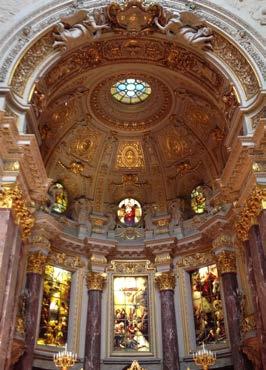

Am Lustgarden, 10178, Mitte | Mon–Sat 9.00–19.00, Sun 12.00–19.00 | Hackescher Markt | 7€/5€ | berlinerdom.de
Words:Kait Macdonald
Checkpoint Charlie

Checkpoint Charlie marks the spot as the most famous crossing point between East and West Berlin during the Cold War. It sits as the focal point of a bustling crossroads flled with Trabant hire cars, tourists and many a souvenir shop. Known as a symbol for the Cold War, the landmark is basically a small checkpoint shed where people could legally cross the Berlin Wall. It is certainly worth a peek if you’re in the area, but it is recommended to combine it with one of the surrounding museums. The Berlin Wall Museum - Museum Haus am Checkpoint Charlie, Exhibition Black Box Cold War or The Wall in Berlin 360 Panorama are all on the square to get some further background information, as little is featured at the site. Also in the area, is a section of the wall still left standing.
. The checkpoint was given the name Charlie simply because there were already two military checkpoints named Alpha and Bravo. The large photograph of a soldier featured at the checkpoint is unfortunately not Charlie and was selected completely at random. A defnite tourist favourite, for those who wish to do so, is to have your photograph taken with the soldiers in costume who man the checkpoint.

Friedrichstraße 43-45, 10117, Kreuzberg | Kochstraße | €€€€€ | Words:Amie Pearce 11AM–7PM
Museum der Dinge Museum of Things

The words that usually come to mind when one thinks of a museum are: sophisticated, informative, sometimes even dull. Not here. This museum houses items that are rarely seen in historical museums. From children’s toys to teapots and seashells to chairs, everyday items dating from the early 20th century to present day are displayed in cabinets. The mundanity is actually fascinating and amusing. The baffement one feels from seeing a fling cabinet frst thing never fully fades, and it only increases once the Levi’s jeans and H&M shirt are found. In case one actually wants a reason as to why there are certain objects here, there are audio clips and some plaques at the end of each row for more information. Although amusing, this museum is best suited for parents with kids or grandparents reliving the glory days.
Oranienstraße 25, 10999, Kreuzberg | Thurs.-Mon. 12.00-19.00 | Bus M29/140 Adalbertstraße/Orienstraße|6€/4€ | museumderdinge.org
Words: Gabrielle Archibald

History-lovers will appreciate a tour of the sad but fascinating Stasi prison. Though perhaps not an activity to do if you’re looking for a fun day out, a tour of the prison gives visitors a chilling but accurate representation of how life for the prisoners would have been and the acts of brutality carried out there. Many of the tour guides have served time at the prison themselves and they give you an eyewitness account of their time there as they guide you through the dank hallways and show you the chalky, claustrophobic cells. Almost everything in the prison is in the same state as it was when it was shut down in 1990 following the fall of the Berlin wall and gives a good idea of the conditions in which prisoners lived. Bringing a bottle of water is recommended as the humidity of the cells can become uncomfortable, especially in the summer months.
Genslerstraße 66, 13055, Lichtenberg | M5 Freienwalder Straße |
9.00–18.00; see website for tour schedules 6€/4€ | en.stiftung-hsh.de Words: Rebecca Gilooly
Tränenpalast – GrenzErfahrungen
Palace of Tears: Border Experiences - Everyday Life in Divided German

The Tränenpalast is the departure hall of the former East-West border crossing at Friedrichstraße station. The name means Palace of Tears, so-called by Berliners because it was there that East Germans said goodbye to relatives and friends travelling back to the West, not knowing when they might see them again. The departure hall was built in 1962 and is a modern construction, made of steel and glass. After the fall of the Wall in 1989 it was used as a nightclub and is now home to a permanent exhibition on the experiences at the checkpoint and the border’s effect on the everyday lives of the Germans. The exhibition is interactive and engaging with many original artefacts and photos, including an original checkpoint booth. The building is bright and airy, especially on a sunny day, which seems particularly incongruous when learning about the traumatic scenes which took place there. Located on the Reichstagsufer, next to the government district and the buildings which are central to the functioning of today’s reunifed Germany, the exhibition is a stark reminder of how different things used to be.
Reichstagufer 17, 10117, Mitte | Tues. - Fri. 9.00 - 19.00 Sat. - Sun. 10.00 - 18.00 |
Words: Zoë Charlesworth
Gedenkstätte Deutscher
Widerstand German Resistance Memorial Center

The Gedenkstätte Deutscher Widerstand is a real treasure for those keen on history, as a wide range of media and material has recently been made into a permanent exhibition and is presented in the rooms where the attempted coup of July 20th 1944 took place. With free entry to both the permanent and the special exhibition, the focus of this museum on a more untold piece of history defnitely makes it worth the visit. The Gedenkstätte Deutscher Widerstand is a real treasure for those keen on history, as a wide range of media and material has recently been made into a permanent exhibition and is presented in the rooms where the attempted coup of July 20th 1944 took place.
While other museums on the Second World War don’t have the time or space to talk about the resistance to Hitler’s dictatorship from 1933-1945 due to the excess of information on Nazi brutality, little is ever really mentioned. However, this aptly sized space provides a spectrum of fghters against the National Socialist party ranging from those who stood down from their military posts once the party came to power to those who directly attempted to assassinate Hitler. Do take note that, although the museum shows the incredible strength and determination of the human spirit through some 40 men and women’s individual stories, the facts are as upsetting as they are extraordinary. It is easily accessible on the 200 bus, which covers major parts of the city, but not so well sign-posted once you’re inside the building. Just follow the stairs up until you reach the permanent exhibition.
With free entry to both the permanent and the special exhibition, the focus of this museum on a more untold piece of history defnitely makes it worth the visit.
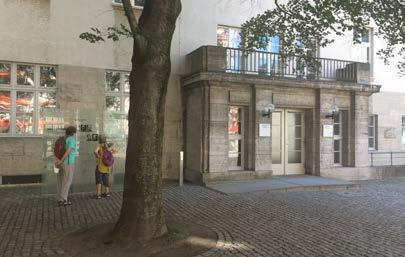
Stauggenbergstraße 13-14, 10785, Mitte | 9:00 – 18:00 | M29 Bus Gedenkstätte Deutscher Widerstand | gdw-berlin.de
Words: Amie Pearce
Alliierten Museum
Allied Museum

Consisting of fve parts, this is the place to go for a quick look at German history after the Second World War. The frst things one notices is the replica of a plane sitting between the two buildings, which are the Outpost Theater and the Nicholson Memorial Library sections of the museum. Take a look inside the Outpost Theater. Inside there are letters, military outfts, medals, and even a propeller of a Douglas C54 plane. Off to the side there’s a small room with only a television playing what was the German news during the Allied occupation of West Berlin. Cross the Open-Air Exhibition to check out more detailed information on the military in Berlin, as well as see the temporary exhibition. It’s recommended to start at the Outpost Theater and make your way to the Friedrich Wilhelm von Steuben Monument for maximum comprehension of historical events.
Clayallee 135, 14195, Dahlem | Tues.-Sun. 10.00-18.00 | Bus 115 Düppel-Süd | | €€€€€ | alliiertenmuseum.de Words: Gabrielle Archibald
Spy Museum

Located in front of the Mall of Berlin, this museum follows the history of spies in action, especially in Berlin, as it was the capital of spies during the Second World War and the Cold War. If you are into movies like James Bond, the Bourne series or Inspector Gadget, this place will be your paradise. The entire exhibition is presented in a modern way. It uses technology and the visitor gets to choose which videos and information to see. The collection of gadgets the museum has is impressive and they are the main attraction. They have cameras, different types of footwear and hearing devices. The admission to this museum is quite expensive so make sure that you are into intelligence agencies and spy technology as otherwise the entrance fee is not worth paying.

A highlight of the visit is attempting to beat the laser beam security system , so forget everything and for a moment act as if you are an agent!
Leipziger Platz 9, 10117, Mitte | 10.00-20.00| spymuseumberlin.com Postdamer Platz |18€ /14€ |
Alte NationalgalerieOld National Gallery

If you have a keen eye for art and culture, the Altes Nationalgalerie is your best pick out of the many to choose from on Museum Island, which is Berlin’s well-established museum quarter. Located in a building with beautiful neoclassical architecture and green garden grounds, the museum is often a flm or photography site. Go here to get your fx of impressionist, early modernist and romantic masterpieces in the permanent exhibition, featuring prominent German artists such as Adolph Menzel and Max Liebermann. Don’t forget to explore their temporary exhibitions, usually featuring captivatingly curated pieces by German and other artists, such as August Kopisch. The temporary exhibitions often pivot around a central theme and explore an artist’s life and story—you won’t be leaving uninspired. Visit the other museums next-door, such as the Alte Museum and Neue Museum, a UNESCO World Heritage site, or walk a few steps and you’ll fnd the glorious Berliner Dom.
Berlinische Galerie
Contemporary Art Gallery

The Berlinische Galerie of contemporary art is located close to the Jewish Museum in Kreuzberg, and is one of Berlin’s best contemporary art galleries to visit. The spacious venue hosts a permanent exhibition upstairs which eloquently takes you through a rather dimly lit labyrinth of the years of German modern art; downstairs usually hosts temporary exhibitions which are often interactive and always very unique. Summer 2016 saw the philosophical work of Erwin Worm displayed across the main foor, including several interactive pieces of art that turned the spectators into the art themselves, and a life-size house depicting the narrow-mindedness of the middle class. Exit through the gift shop and get yourself one of the gallery’s posters used to advertise their exhibitions, often just as cool as what’s in the gallery itself.

König GalerieContemporary Art Gallery


This small and well-reputed contemporary art gallery in Kreuzberg showcases rotating exhibitions featuring Berlin-born and international artists in a space which will leave a strong impression on its visitors. The gallery is housed in the St Agnes Church built in 1967; the architecture of St Agnes Church is a masterpiece in itself, and a prime example of Brutalist German architecture, recently reeling in recognition and awards such as the Berlin Architecture prize in 2015 chaired by the director of the Tate Modern, London. The gallery consists of two levels with high ceilings and open spaces creating a reflective ambiance to ponder works of contemporary art and photography such as that of Jeremy Shaw and Jorinde Voigt exhibited in the summer months of June and July 2016. This gallery is one of the many buildings in Berlin that have been repurposed and reinvented, part of what creates the creatively nurturing atmosphere Berlin is so famous for. Easily museum hop to the Berlinische Galerie down the road or the Jüdisches Museum and make a day of nurturing the mind.
Moritzplatz | €€€€€ |
Words: Milan Cater
East Side Gallery

Stretching 1.3 km along the River Spree, the East Side Gallery is the longest segment of the Berlin Wall still standing, and by far the most colourful. While most of the Wall was dismantled shortly after November 1989, this section became the world’s largest open air mural collection in 1990 when over 100 international artists painted its east side. Featuring a wide variety of artistic styles, the murals are a mix of political statements, surreal images and representations of the euphoric atmosphere of 1989-1990. The most iconic paintings, like the kiss between Erich Honecker and Leonid Brezhnev by Vrubel Dimitrji and the Trabi breaking through the wall by Birgit Kinder, often have crowds of people waiting to take photos. Whether your interests lie in art or history, the East Side Gallery is worth visiting and if you go in the early morning or late evening there’ll be fewer tourists. Nearby is the RAW Gelände, a creative area of bars and clubs near Warschauer Straße, as well as the Oberbaumbrücke, a grand red brick bridge with turreted towers leading across the Spree to Kreuzberg.
Mühlenstraße, 10243, Friedrichshain | Warschauer Straße |€€€€€ | eastsidegallery-berlin.de Words: Zoë Charlesworth
Jüdisches Museum
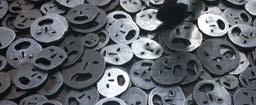
This museum is dedicated to the Jewish community and showcases the vital role Jews have played in the history of Berlin and in the modern world. This museum is a centre for learning and both showcases art while being a work of art in itself. Conceptualised and created by architect Daniel Liebeskind, the architectural composition of the museum is quite interesting as the main fgure is a zigzag. The permanent exhibition is a careful topopgraphy of Jewish culture. Inside the building’s basement you will fnd three corridors that are called the “Axes”. The Holocaust Tower is an impressive representation of isolation as it is a cold, dark, concrete space with only one ray of natural light entering near the top. The Jewish museum offers the opportunity to better understand Jewish history and culture as it explains their diet, education, origin and traditions like the Bar Mitzvah.
WORDS: ERICA REYES & MILAN CATER

One part of the exhibition focuses on heartfelt stories of Jewish people during the Second World War. Letters, photos and personal objects accompany the stories to make them feel closer to the heart. Many interactive displays draw in visitors and make the experience very personable and impactful. Audio guides are available, although it depends on the number of visitors as they sometimes run out. The estimated time needed to cover the permanent exhibition in the museum is between two to three hours.
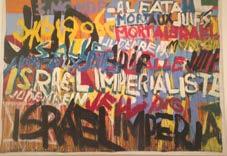
The temporary exhibition space in the Jewish Museum is just as inspiring and worth visiting, as it appeals to a contemporary and more artistic rather than historical representation of Jewish culture. It often features comptemporary work by Jewish artists, or explores issues Jewish culture faces today. Previous exhibitions included GEHORSAM: OBEDIENCE, an exhibition in 2015 exploring the similarities and differences in the approach to religious obedience by people of Christian, Islamic and Jewish faith. More recent exhibtions in 2016 are of over 200 works by Boris Lorie, a Jewish holocaust survivor of more than one concentration camp, who emigrated to New York and expressed his thoughts on American culture through vivid art and collages often featuring pin-ups and exploring female objectifcation.

Lindenstraße 9-14, 10969, Kreuzberg Bus 248 Jüdisches Museum jmberlin.de 10.00-20.00





